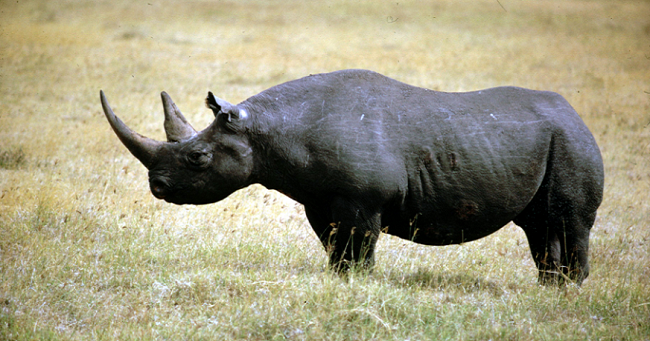


The onslaught of the human population is slowly taking a toll on its natural resources. The first to suffer of course is wildlife among which rare species of animals have gradually declined in number and gone extinct. Today man can only enjoy the pleasure of seeing such creatures in stone or through replicas created by studying fossils which are all that is left of them. Fortunately, there have been animals that have been driven to extinction in recent times whose records do exist even on video so take a look at 10 extinct animals.
The quagga lived in South Africa as a sub species of the zebra. It appeared during the Pleistocene period till the 19th century and looked like a combination of a horse and Zebra. Quaggas existed in great numbers in karoo of Cape Province and southern Orange Free State of South Africa. Their numbers began dwindling after the Dutch began settling in South Africa. Heavy hunting caused their ultimate extinction where the last animal died in captivity in Amsterdam in 1878.

Image Source: www.bluewin.ch
The Bubal Hartbeest was a sandy colored herbivore that roamed the entire north of the Saharan Desert surrounding Morocco and Egypt. They existed in herds of at least two hundred and thronged areas with adequate vegetation. During the French occupation of Algeria in the 19th century, their numbers dwindled because of hunting bringing the herds down to just one group of 15 which was observed in Morocco in 1917. The last recorded bubal hartebeest was killed in the wild in 1925 at Missur, Morocco.
Image Source: www.pinimg.com
This was a small wild fowl and a subspecies of the prairie chicken found in pre revolution times in the eastern USA from Maine to Virginia. Their numbers dwindled due to rampant human consumption as they made a tasty meal. By the 1870’s only a few heath hens existed on Martha’s Vineyard off the coast of cape Cod in Massachusetts. Although a sanctuary was set up for their protection in 1908, a fire ended up destroying their habitat. The last male heath hen died in 1932.
Image Source: www.ytimg.com
Among extinct animals, the thylacine was a dog like animal that had an abdominal pouch like a kangaroo. They were also referred to as the Tasmanian Tiger because of their markings that featured transverse stripes on their backs. Thylacines were predators native to Tasmania Australia and New Guinea. The animals survived till the 1930’s where the last surviving thylacine was shot in 1930 by Wilf Batty a farmer from Mawbanna. Benjamin was the last thylacine who died in captivity in Hobart Zoo in 1936.
Image Source: www.pinimg.com
As a subspecies of lions, the Barbary lion lived in North Africa and were known as the Atlas Lion. They were known for their dark long colored manes that extended down to their belly. The growth of manes was influenced by temperature and level of testosterone. Having once walked in significant numbers in the wild, the Barbary lions are extinct in the wild with the last one shot in Moroccan Atlas Mountains in 1942.
Image Source: www.20minutos.es
A Laysan rail was first spotted in 1828 by Russian sailors in 1828 in Laysan Hawaii. It looked just six inches and was a fearless bird similar to the species in Lisianski. The birds usually fed off scraps of bird carcasses, flies and moths. When rabbits were introduced in Laysan, most of the vegetation was destroyed leading to their extinction. Till 1910 there were about 2000 Laysan rails but the last of them was spotted in Midway in June 1944.
Image Source: www.wikimedia.org
Known as the West Indian Seal and native to the Caribbean, they were first sighted in 1494 by Columbus who called them sea wolves. It was Spanish explorers who threatened their extinction by killing them for fur, meat oil and hide. A solitary Caribbean monk seal was last spotted in 1952 at Serranilla Bank between Jamaica and Nicaragua.
Image Source: www.wikimedia.org
The Tecopa pupfish were once found in the outflows of water in the South and North Tecopa Hot Springs. These are small fish that eat mostly larva and were first noticed by Robert Miller in 1848. It was human encroachment that ultimately led to the extinction of the pupfish. The popularity of the hot springs drove the fish downstream where cold waters and swift currents did not provide them ideal living conditions. The last a pupfish was seen was on February 2, 1970.
Image Source: www.tqn.com
The now extinct Java Tiger lived on the Java Islands of Indonesia and were common in the early 19th century. Considered pests, they were hunted and poisoned in large numbers. Ultimately they were driven to extinction due to shortage of their natural habitat. In 1972 only seven to twelve of the species remained. That too disappeared with no indication of any sighting ever since. It now remains among the list of extinct animals that once roamed the earth.
Image Source: www.pinimg.com
As a sub species of the black rhino, the western black rhino roamed the southeast region of Africa in large numbers. Heavy hunting in the early 20th century reduced their population but in the thirties, preservation efforts helped their numbers rise, however, the efforts lost steam resulting in the total decline of the western black rhino where only 5 remained in the eighties. The IUCN declared the animal extinct in 2006.
Image Source: www.ebaumsworld.com